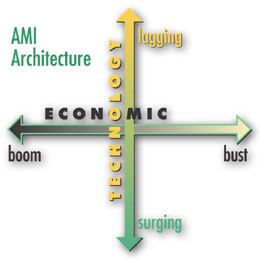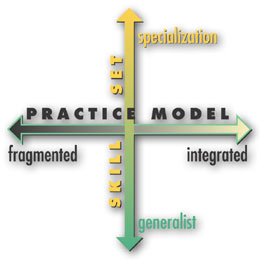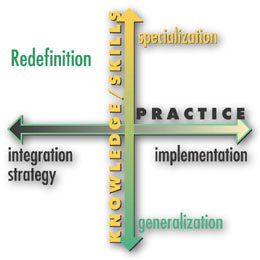
Professionals help build a better matrix

AIA Resident Fellow, Marketplace Research
 Last
month we presented a scenario matrix for redefining the profession. The
following article builds on that scenario, courtesy of feedback from Marcia
Hart, AIA, of OPX, and Robin Ellerthorpe, FAIA, of OWP&P.
Last
month we presented a scenario matrix for redefining the profession. The
following article builds on that scenario, courtesy of feedback from Marcia
Hart, AIA, of OPX, and Robin Ellerthorpe, FAIA, of OWP&P.
This redefinition scenario actually got started when a group of young architects and architecture students gathered for the AIA's "Point Break" symposium in San Francisco last fall and began defining the context to create a scenario for the future of the profession. Defining the context in four parts—Society, Culture, Environment and Economy—the issues ranged wide, from "doing the most good for the most people" to "elitism" and "fragmentation" in Society, to "gaining value from environmentally friendly actions" to "deriving value from focused economic actions," in Environment. Most interestingly, the scenario created by future architects was decidedly in contrast to that of the established practitioners, such as that established by AMI Architecture and published in the September 2001 issue of Architecture magazine.
 Our
redefinition scenario builds on that of the future architects, using decisions
design organizations are making today to succeed in the future. To present
redefinition principles, we developed the following matrix, with the variables
of Skill Sets and Practice Models.
Our
redefinition scenario builds on that of the future architects, using decisions
design organizations are making today to succeed in the future. To present
redefinition principles, we developed the following matrix, with the variables
of Skill Sets and Practice Models.
Refinement of the
matrix
Hart contends that the "Skill Set" variable should instead be
"Skill Application," because it is the actual application of
the skill that produces concrete value in a project. Ellerthorpe agrees
that a Skill Set is potential; it is leverage, and once you apply a skill
it is locked. He says Skill Sets in electrical terms would be voltage
(as in potential), while Skill Application is aperture (as in active usage).
So, should the variable be simply—"Skills," which encompasses
both potential and action?
 Hart
suggests that the "Practice" variable, should go from "Integrated"
over to "Fragmented," rather than vice-versa. In fact, she would
change "Integrated" to "Strategic," because it implies
planning, that is, being ahead of the client by understanding what it
is the client needs to know. Likewise, "Fragmented " should
instead be "Implementation," in which the process is architecture;
that is, the design, or making money for the client.
Hart
suggests that the "Practice" variable, should go from "Integrated"
over to "Fragmented," rather than vice-versa. In fact, she would
change "Integrated" to "Strategic," because it implies
planning, that is, being ahead of the client by understanding what it
is the client needs to know. Likewise, "Fragmented " should
instead be "Implementation," in which the process is architecture;
that is, the design, or making money for the client.
Concentrating on
the work, not the product
When you talk of making money for the client, we know that clients concentrate
on operations, rather than just the facility. Clients care about how the
company works. So, to whom within the corporate structure does architect
needs to relate?
Hart believes it is the Chief Operating Officer (COO), because the architect needs to grasp the company's business strategy, workplace, staffing levels, and performance issues. Hart feels that a company's organization has connection points to various professions:
• The Chief Operating Officer connects to the
architect
• The Chief Financial Officer connects to the accountant
• The Chief information Officer connects to information technology
specialist
• The Chief Personnel Officer connects to the human resources specialist
.
The architect's connection, the COO, knows all about core competency and accessibility, and provides a connection to other critical players. It's about how we think about clients rather that the project, Hart maintains. We must identify the project with the work, not with the product. At the foundation of every project is the client's business. Architects help clients succeed through design, which takes us back to—ideas, information, and relationships, all connected to innovation.
An example: SHAPE
John Galloway, AIA, principal of newly formed SHAPE, is guiding his firm
from the established principle of "excluding services" to the
trend of an "include services" attitude. In fact, Galloway defines
SHAPE by its organization, scope, and process. The firm looks at the client's
organization and environmental pressure points to define the client's
project "topography." Then, they can offer the client focused
services performed by "deep knowledge" cross-discipline teams
that match the topography. "We define our capabilities by our client's
needs, or helping clients defining their needs," Galloway says. He
agrees with Hart in that the "Integration" module on the Practice
axis should be defined as "Strategic," because this type of
service starts with research, and could move all the way across the axis
to "Implementation." In our model, SHAPE is focusing on the
Specialization on the Skill axis, and on Strategy/Integration on the Practice
axis.
 Out
of the far edge
Out
of the far edge
Hypercompetition: Managing the Dynamics
of Strategic Maneuvering, by Richard A. D'Aveni and Robert Gunther
(Free Press, 1994) tells us that "Strategic soothsaying is a process
of seeking out new knowledge necessary for predicting or even creating
new temporary windows of opportunity that competitors will eventually
enter but that are not served by anyone else." Hypercompetitors find
new or superior ways to satisfy clients. They need two competencies: motivated
and empowered workers at all organizational levels, and knowledge of the
future or an ability to create the future (i.e., discover and identify
client needs not yet known to the client).This skill would fall on the
far, far left of Strategic on the Practice axis. By being located at the
far edge, hypercompetitor skills woud include understanding the larger
contextual trends and seeking to understand the peripherals.You might
sum it up this way: "Knowledge plus integration enables innovation
("the far edge"), which equals client satisfaction and competitive
advantage."
Next month, a look at the Point Break scenarios and translating design knowledge to organizational knowledge within the context of the redefinition scenario.
So, do you agree with the proposed refinement of the Redefinition Scenario? Contact Richard Hobbs.
Copyright 2002 The American Institute of Architects. All rights reserved.
![]()
|
Review Mr. Hobbs' previous article. The author would like to acknowledge the contribution of the Wallace Group. |
|